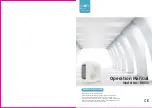
10. Decommissioning
Before carrying out this procedure, it is essential that the technician is completely familiar with the equipment and all its details.
It is recommended good practice that all refrigerants are recovered safely.
Prior to the task being carried out, an oil and refrigerant sample shall be taken in case analysis is required prior to re-use
of reclaimed refrigerant.
It is essential that electrical power is available before the task is commenced.
a) Become familiar with the equipment and its operation.
b) Isolate system electrically.
c) Before attempting the procedure ensure that:
- mechanical handling equipment is available, if required, for handling refrigerant cylinders;
- all personal protective equipment is available and being used correctly;
- the recovery process is supervised at all times by a competent person;
- recovery equipment and cylinders conform to the appropriate standards.
d) Pump down refrigerant system, if possible.
e) If a vacuum is not possible, make a manifold so that refrigerant can be removed from various parts of the system.
f) Make sure that cylinder is situated on the scales before recovery takes place.
g) Start the recovery machine and operate in accordance with manufacturer's instructions.
h) Do not overfill cylinders. (No more than 80 % volume liquid charge).
i) Do not exceed the maximum working pressure of the cylinder, even temporarily.
j) When the cylinders have been filled correctly and the process completed, make sure that the cylinders and
the equipment are removed from site promptly and all isolation valves on the equipment are closed off.
k) Recovered refrigerant shall not be charged into another refrigeration system unless it has been cleaned and checked.
11. Labelling
Equipment shall be labelled stating that it has been de-commissioned and emptied of refrigerant.
The label shall be dated and signed.
Ensure that there are labels on the equipment stating the equipment contains flammable refrigerant.
12. Recovery
When removing refrigerant from a system, either for servicing or decommissioning, it is recommended good practice that
all refrigerants are removed safely.
When transferring refrigerant into cylinders, ensure that only appropriate refrigerant recovery cylinders are employed.
Ensure that the correct number of cylinders for holding the total system charge are available.
All cylinders to be used are designated for the recovered refrigerant and labelled for that refrigerant.
Cylinders shall be complete with pressure relief valve and associated shut-off valves in good working order.
Empty recovery cylinders are evacuated and, if possible, cooled before recovery occurs.
The recovery equipment shall be in good working order with a set of instructions concerning the equipment that is at hand
and shall be suitable for the recovery of flammable refrigerants.
In addition, a set of calibrated weighing scales shall be available and in good working order.
Hoses shall be complete with leak-free disconnect couplings and in good condition.
Before using the recovery machine, check that it is in satisfactory working order, has been properly maintained and
that any associated electrical components are sealed to prevent ignition in the event of a refrigerant release.
Consult manufacturer if in doubt.
The recovered refrigerant shall be returned to the refrigerant supplier in the correct recovery cylinder,
and the relevant Waste Transfer Note arranged.
Do not mix refrigerants in recovery units and especially not in cylinders.
If compressors or compressor oils are to be removed, ensure that they have been evacuated to an acceptable level to
make certain that flammable refrigerant does not remain within the lubricant.
The evacuation process shall be carried out prior to returning the compressor to the suppliers.
Only electric heating to the compressor body shall be employed to accelerate this process.
When oil is drained from a system, it shall be carried out safely.
04-04
CAUTION
Summary of Contents for AOTG36LATT
Page 4: ...2008 11 20 3 31 12 330 900 1290 9 21 OUTDOOR UNIT unit mm 650 400 370 air flow ...
Page 30: ...1204G4067 ...
Page 34: ...Unit mm 2012 05 29 3 AOTG12LVCC OUTDOOR UNIT AOTG09LVCC 540 290 790 540 540 660 290 450 ...
Page 60: ...1205G4083 ...
Page 85: ...1307G4239 ...
Page 113: ......
Page 114: ...1 DESCRIPTION OF EACH CONTROL OPERATION WALL MOUNTED type INVERTER ...
Page 135: ......
Page 136: ...2 TROUBLE SHOOTING WALL MOUNTED type INVERTER ...
Page 169: ......
Page 170: ...3 APPENDING DATA WALL MOUNTED type INVERTER ...
Page 176: ...4 INSTALLATION WORK WALL MOUNTED type INVERTER ...
Page 181: ......
Page 187: ......
Page 188: ...1116 Suenaga Takatsu ku Kawasaki 213 8502 Japan September 2013 Printed in Japan ...
Page 190: ...1 INDOOR UNIT WALL MOUNTED TYPE ASTG18KMCA ASTG22KMCA ASTG24KMCA DTR_AS082E_02 2013 09 13 ...
Page 221: ...2 OUTDOOR UNIT SINGLE TYPE AOTG18KMCA AOTG22KMCA AOTG24KMCA DTR_AO144E_02 2013 09 13 ...
Page 236: ... 02 14 OUTDOOR UNIT AOTG18 24KMCA OUTDOOR UNIT AOTG18 24KMCA SOUND LEVEL CHECK POINT 88888 ...
Page 264: ...1208G4097 ...
















































